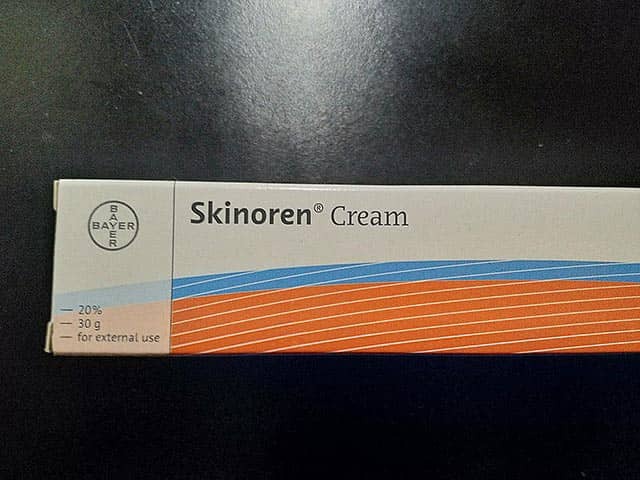Main menu
Common skin conditions

NEWS
Join DermNet PRO
Read more
Quick links
Last Reviewed: November, 2022
Introduction
Uses
Contraindications
More information
Benefits
Disadvantages
Side effects and risks
Azelaic acid is a dicarboxylic acid molecule with anti-inflammatory and antioxidant properties, effective in the treatment of acne vulgaris and papulopustular rosacea, among other cutaneous conditions.
Azelaic acid is a naturally occurring by-product of the metabolism of the yeast Malassezia furfur (also known as Pityrosporum ovale). In a number of countries, azelaic acid is available at a concentration of 20% as Skinoren™ cream, Acnederm™ lotion, and Azclear™ lotion. A 15% azelaic acid gel preparation was also approved for use in the US for rosacea, and a number of European countries for both rosacea and acne, eg, Finacea™ gel.

Pharmaceutical preparation of azelaic acid
Azelaic acid is predominantly used as a topical treatment for mild to moderate acne, and may be combined with oral antibiotics or hormonal therapy. It is useful for both comedonal and inflammatory acne vulgaris.
Azelaic acid, a tyrosine inhibitor, also helps reduce pigmentation, therefore is particularly useful for darker skinned patients whose acne spots leave persistent brown marks (postinflammatory pigmentation) or who have melasma.
Although not registered in New Zealand for other skin disorders, azelaic acid products may also be useful in the treatment of:
Azelaic acid has the following properties:
Azelaic acid cream should be applied to the area affected by acne initially daily, then if tolerated building up to a generous twice-daily application after thoroughly cleansing the skin.
Acne responds slowly to treatment. Some improvement should be seen after one month of using azelaic acid cream. Further improvement should occur with maximum results after six months continuous use. Treatment may be continued safely for months or years if the acne remains active.
Azelaic acid has both anti-inflammatory properties and targets hyperpigmentation. Its keratolytic properties means it is both exfoliative and comedolytic. It is a good option for acne treatment, with milder side-effects compared to more potent therapies. Some evidence suggests it is probably similarly effective to tretinoin for the treatment of acne.
Azelaic acid does not result in:
Azelaic acid is nontoxic and is well tolerated by most subjects. However, those with very sensitive skin or who suffer from eczema may find it irritating to apply, resulting in a mild irritant contact dermatitis.
Discontinue applying the cream and seek medical advice if you develop severe:
Worsening of asthma has also been reported with azelaic acid treatment; consult a physician if asthma exacerbation occurs with use.
Approved datasheets are the official source of information for medicines, including approved uses, doses, and safety information. Check the individual datasheet in your country for information about medicines.
We suggest you refer to your national drug approval agency such as the Australian Therapeutic Goods Administration (TGA), US Food and Drug Administration (FDA), UK Medicines and Healthcare products regulatory agency (MHRA) / emc, and NZ Medsafe, or a national or state-approved formulary eg, the New Zealand Formulary (NZF) and New Zealand Formulary for Children (NZFC) and the British National Formulary (BNF) and British National Formulary for Children (BNFC).